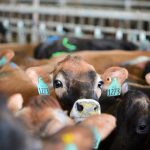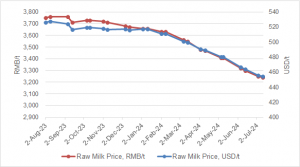
Intense competition forces companies to seek out new areas of growth in one of world’s biggest dairy markets.
Dairy companies are shifting their focus in China from babies to adults, as a falling birth rate and intense competition force them to search for new areas of growth in what has long been one of the world’s biggest markets for milk.
The A2 milk company, headquartered in New Zealand, last month announced new milk powder products for the “adult and ageing population” in China, adding to similar products offered by companies such as Danone, Abbott, Fonterra and Nestlé as well as domestic names such as Yili and Feihe.
“There’s a lot of attention now on senior nutrition, sports nutrition, and other applications for these [dairy] ingredients,” said Conor O’Sullivan, China manager for Bord Bia, Ireland’s food trade body. “To some extent new occasions for consumer dairy are being created,” he added.
“Many categories in the Chinese food industry are facing oversupply and weak demand at the moment, and they’re looking for growth,” said O’Sullivan.
China’s birth rate hit a record low of 6.4 births per 1,000 people in 2023, official data shows, while its population is rapidly ageing, a demographic shift that is expected to reshape the economy and consumer markets.
Rabobank forecasts dairy demand in China, the world’s biggest importer of milk, to grow 2.4 per cent annually in the years to 2032, but sees infant formula reaching a “negative volume growth rate” in coming years. The infant formula market is a “crowded space” with “intensifying” competition, wrote Michelle Huang, a Rabobank analyst, in a report this year, suggesting diversification into sectors including “adult and medical nutrition”.
Foreign milk producers once dominated the dairy sector, the initial expansion of which in the 1980s embodied the country’s reopening to the world. Many consumers opted for foreign milk after several babies died and tens of thousands were hospitalised in 2008 after consuming milk formula from domestic company Sanlu Group.
But they now face an increasingly saturated market as homegrown milk producers increase output. The shift, which is echoed across consumer markets from coffee to autos, has come alongside a government drive for higher self-sufficiency and greater regulatory control, especially in the sensitive infant milk sector.
“In China, you’ve got a basic brand, a premium brand, a super-premium brand, a hyper-premium brand,” said one person involved in the dairy industry on the intense competition. Domestic milk supply is “growing very fast”, the person added.
Jason Yu, a managing director at Kantar Worldpanel, said that “almost every city has a local dairy company in China” but added that government efforts to improve safety have since encouraged consolidation. In the past year, the top 10 brands in the infant milk formula market had 80 per cent of the market, he said, and half of them were Chinese.
US company Abbott closed its infant formula business in China at the end of 2022 to focus more on adult products. Nestlé similarly closed a factory in Ireland last year, in part due to pressures in a Chinese market where dozens of products vie for consumers’ attention.
In one Shanghai supermarket, in a separate section to similarly branded products for infants, an entire section is devoted to adult milk products with widespread references to their protein and calcium content. The A2 milk company, which continues to provide infant products, said its new product for older consumers had been formulated to provide additional benefits to support the “health of the immune system” as well as “bone, joint and muscle health”.
A Feihe product for the elderly uses several formulas including one that is low-glycemic, meaning it has less impact on blood sugar levels. The product is based on the concept of “greater suitability” to meet the “different needs of middle-aged and elderly people”, a state media report said.
You can now read the most important #news on #eDairyNews #Whatsapp channels!!!
🇺🇸 eDairy News INGLÊS: https://whatsapp.com/channel/0029VaKsjzGDTkJyIN6hcP1K

























